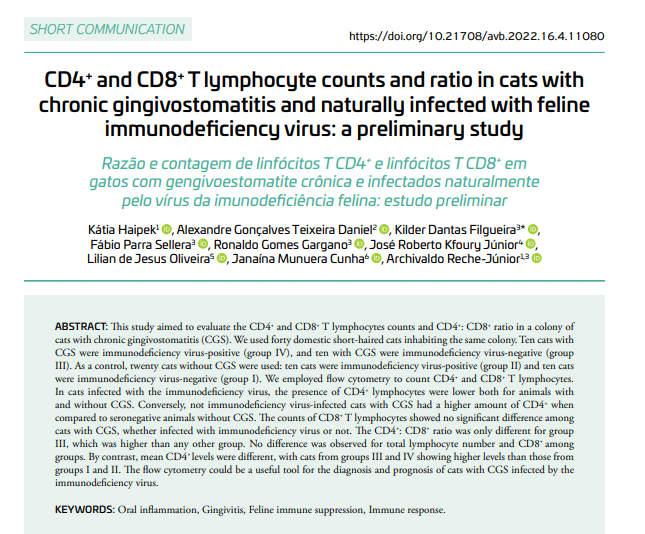CD4+ and CD8+ t lymphocyte counts and ratio in cats with chronic gingivostomatitis and naturally infected with feline immunodeficiency virus: a preliminary study
DOI:
https://doi.org/10.21708/avb.2022.16.4.11080Resumo
This study aimed to evaluate the CD4+ and CD8+ T lymphocytes counts and CD4+: CD8+ ratio in a colony of cats with chronic gingivostomatitis (CGS). We used forty domestic short-haired cats inhabiting the same colony. Ten cats with CGS were immunodeficiency virus-positive (group IV), and ten with CGS were immunodeficiency virus-negative (group III). As a control, twenty cats without CGS were used: ten cats were immunodeficiency virus-positive and (group II) and ten cats were immunodeficiency virus-negative (group I). We employed flow cytometry to count CD4+ and CD8+ T lymphocytes. In FIV-infected cats, the presence of CD4+ lymphocytes were lower both for animals with and without CGS. Conversely, non-FIV-infected cats with CGS had a higher amount of CD4+ when compared to seronegative animals without CGS. The counts of CD8+ T lymphocytes showed no significant difference among cats with CGS, whether infected with FIV or not. The CD4+: CD8+ ratio was only different for group III, which was higher than any other group. No difference was observed for total lymphocyte number and CD8+ among groups. By contrast, mean CD4+ levels were different, with cats from groups III and IV showing higher levels than those from groups I and II. The flow cytometry could be a useful tool for the diagnosis and prognosis of cats with CGS infected by the immunodeficiency virus.
Downloads

Downloads
Publicado
Edição
Seção
Licença
Copyright (c) 2022 Acta Veterinaria Brasilica

Este trabalho está licenciado sob uma licença Creative Commons Attribution 4.0 International License.
Autores que publicam na Acta Veterinaria Brasilica concordam com os seguintes termos: a) Autores mantém os direitos autorais e concedem à revista o direito de primeira publicação, com o trabalho simultaneamente licenciado sob a Licença Creative Commons Attribution que permite o compartilhamento do trabalho com reconhecimento da autoria e publicação inicial nesta revista. b) Autores têm autorização para assumir contratos adicionais separadamente, para distribuição não-exclusiva da versão do trabalho publicada nesta revista (ex.: publicar em repositório institucional ou como capítulo de livro), com reconhecimento de autoria e publicação inicial nesta revista. c) Autores têm permissão e são estimulados a publicar e distribuir seu trabalho online (ex.: em repositórios institucionais ou na sua página pessoal) a qualquer ponto antes ou durante o processo editorial, já que isso pode gerar alterações produtivas, bem como aumentar o impacto e a citação do trabalho publicado (Veja O Efeito do Acesso Livre).


 Esta obra está licenciada com uma Licença
Esta obra está licenciada com uma Licença 